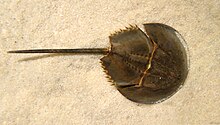Carcinoscorpius
| Carcinoscorpius rotundicauda | |
|---|---|
 |
|
| Scientific classification | |
| Kingdom: | Animalia |
| Phylum: | Arthropoda |
| Class: | Merostomata |
| Order: | Xiphosura |
| Family: | Limulidae |
| Genus: |
Carcinoscorpius Pocock, 1902 |
| Species: | C. rotundicauda |
| Binomial name | |
|
Carcinoscorpius rotundicauda (Latreille, 1802) |
|
| Synonyms | |
|
Limulus rotundicauda Latreille, 1802 |
|
Limulus rotundicauda Latreille, 1802
The mangrove horseshoe crab (Carcinoscorpius rotundicauda) is a chelicerate arthropod found in marine and brackish waters. Despite its name, it is more closely related to spiders and scorpions (all are in the subphylum Chelicerata) than to crabs. It is the only species in the genus Carcinoscorpius. The mangrove horseshoe crab occurs only in Asia and can be found in India, Indonesia, Malaysia, the Philippines, Singapore, Thailand and Hong Kong. There are four extant species of horseshoe crab. The biology, ecology and breeding patterns of C. rotundicauda and the two other Asian horseshoe crab species, Tachypleus gigas and Tachypleus tridentatus, have not been as well documented as those of the North American species Limulus polyphemus. All four extant species of horseshoe crabs are anatomically very similar.
Horseshoe crabs are commonly known by biologists around the world as a living fossil because they have remained practically unchanged in terms of shape and size for millions of years. Although their physiology has changed over the years, their typical three piece exoskeleton, consisting of a prosoma, opisthosoma, and telson, has remained since the mid-Paleozoic era. Fossils of horseshoe crabs that have been dated to over 400 million years ago look almost identical to those species that are still alive today. The long existence of this body plan suggests its success. It is estimated that the American species of horseshoe crab diverged from the three Indo-Pacific species approximately 135 million years ago.
...
Wikipedia

